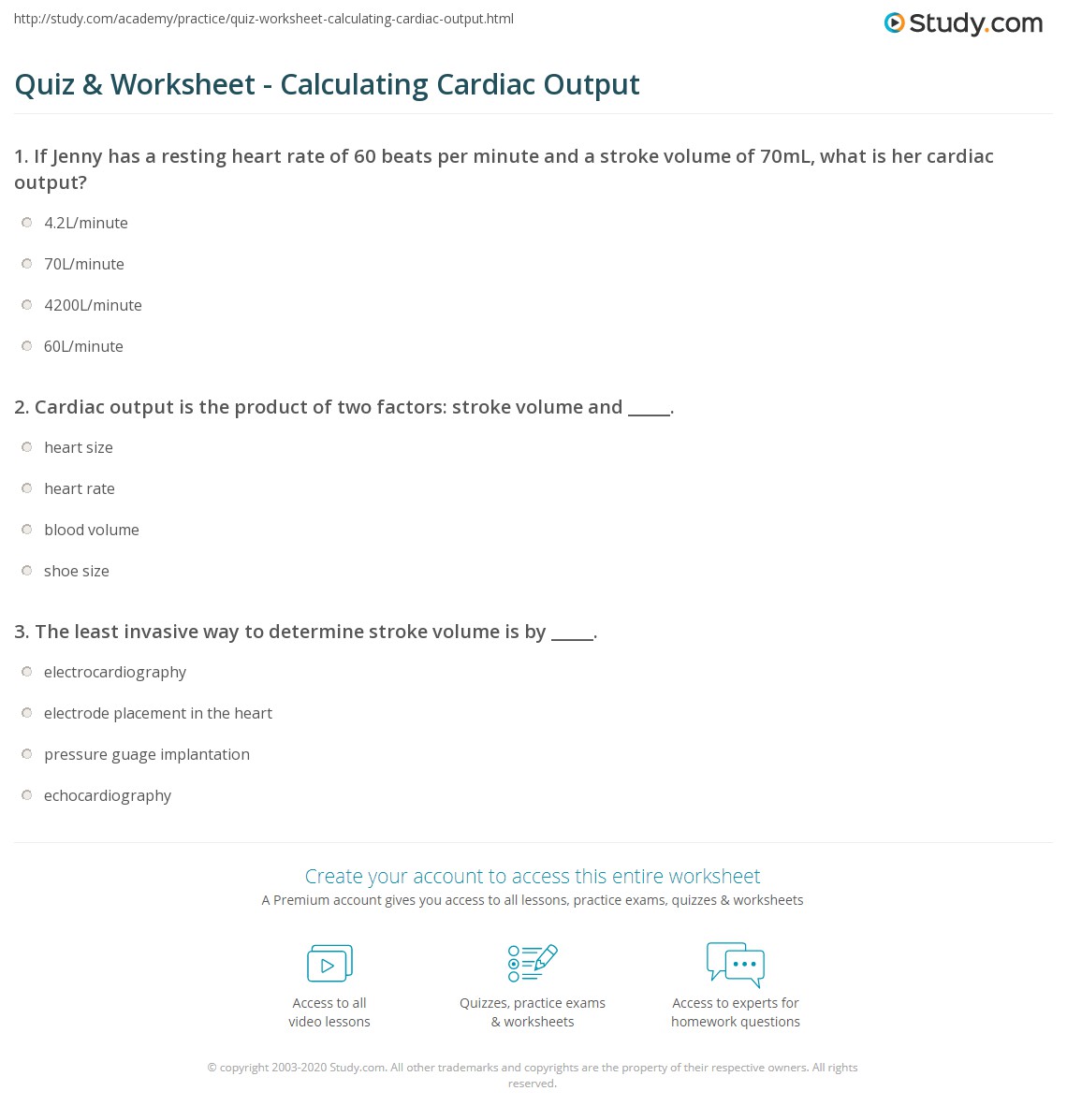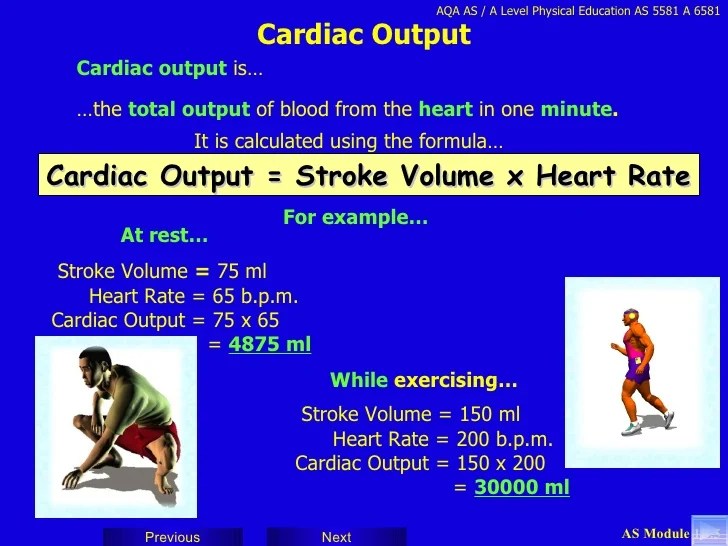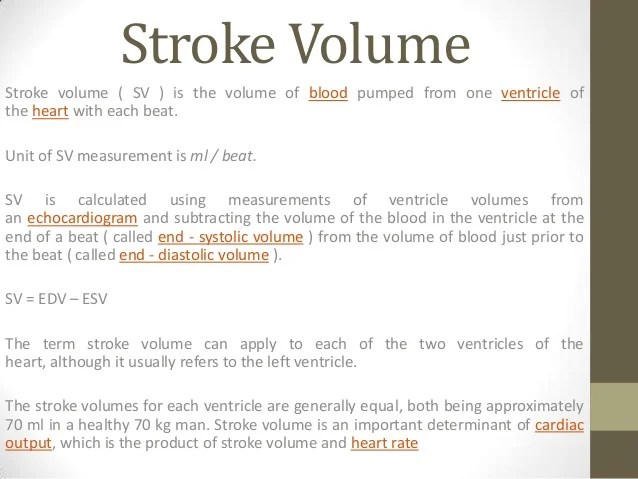4.9 litres per minute = 0.07 litres × 70 beats per minute. For example, if the stroke volume at rest is 70 ml and the heart rate is 70 bpm, then the cardiac output is 70 × 70 ml per minute = 4900 ml/min or 4.9 l/min.
Free How Do You Calculate Stroke Volume And Cardiac Output With New Ideas, (sv) stroke volume(hr) heart ratecardiac output (co): The formula is heart rate x stroke volume = cardiac output.
 "Cardio" Part 1 Why LowIntensity Matters Trainerize.me From trainerize.me
"Cardio" Part 1 Why LowIntensity Matters Trainerize.me From trainerize.me
Simply divide this figure by the heart rate in beats every 60 seconds. Stroke distance calculation is a key step in this process. Stroke volume equals cardiac output divided by heart rate. The stroke volume and the heart rate determine the cardiac output.
"Cardio" Part 1 Why LowIntensity Matters Trainerize.me The stroke volume and the heart rate determine the cardiac output.
4.9 litres per minute = 0.07 litres × 70 beats per minute. Calculating sv or hr for example, if the stroke volume at rest is 70 ml and the heart rate is 70 bpm, then the cardiac output is 70 × 70 ml per minute. Velocity time integral (vti, stroke distance) the formula q = a · v states that flow (q) is the product of area (a) of the cylinder and the velocity (v) of the fluid (i.e blood). To understand the principles of cardiac stroke volume (sv), it is necessary first to define the concept of cardiac output.
 Source: medcareinformation.blogspot.com
Source: medcareinformation.blogspot.com
4.9 litres per minute = 0.07 litres × 70 beats per minute. (sv) stroke volume(hr) heart ratecardiac output (co): A normal adult has a cardiac output of 4.7 liters (5 quarts) of blood per minute. Heart rate is the speed of the heartbeat measured by the number of contractions of the heart per minute. Health Updates Shock.

The cardiac output from stroke volume and heart rate calculator computes the output of a heart based on the heart stroke volume and the heart rate. Your healthcare provider can figure this out with this cardiac output equation: The output is returned in liters per minute (l/min). Multiply stroke volume by heart rate. Question on calculating cardiac output The Student Room.
 Source: study.com
Source: study.com
Cardiac output is how many liters of blood your heart pumps in one minute. Cardiac output is = heart rate x stroke volume and stroke volume = lvot area x lvot vti. This is a relatively simple calculation which identifies the amount of blood your heart pumps in one minute. Sv is the difference between end diastolic volume (edv) and end systolic volume (esv). Quiz & Worksheet Calculating Cardiac Output.
 Source: slideshare.net
Source: slideshare.net
Stroke volume (the amount of blood your heart sends to your body in one heartbeat) can vary based on how hard your heart muscles. Factors that change either edv or esv will change sv. Lv stroke volume = 3.14 (2.0cm/2)^2 x 19cm = 60 cm^3 or 60 ml if the heart rate is 100 then cardiac output = hr x sv = 100 beats/min x 60 ml/beat = 6000 ml/min or 6.0l/min The stroke volume and the heart rate determine the cardiac output. cardiac output.
 Source: slideserve.com
Source: slideserve.com
It refers to how much blood your heart pumps per minute, not beat. You can calculate cardiac output using stroke. The output is returned in liters per minute (l/min). Cardiac output is = heart rate x stroke volume and stroke volume = lvot area x lvot vti. PPT How do we measure heart performance? Cardiac Output = Blood.
 Source: slideserve.com
Source: slideserve.com
Furthermore, cardiac output is 3 to 5 liters per minute while stroke volume is. Stroke volume (sv) is the volume of blood in millilitres ejected from the each ventricle due to the contraction of the heart muscle which compresses these ventricles. Stroke volume is the volume of blood pumped from the left ventricle per beat. So stroke volume= 3.14 (lvot diameter/2)^2 x lvot vti. PPT How do we measure heart performance? Cardiac Output = Blood.
 Source: youtube.com
Source: youtube.com
To understand the principles of cardiac stroke volume (sv), it is necessary first to define the concept of cardiac output. Thus, linear variables are converted to volumetric variables. If you recall the meaning of cardiac output, it is the amount of blood pumped by the heart in a minute. But, stroke volume (sv) is the volume of blood pumped out of the left ventricle of the heart in each heartbeat. blood flow factors involved with cardiac output and resistance. YouTube.
 Source: pinterest.com
Source: pinterest.com
Finally, to determine your cardiac output, multiply your heart rate by your stroke volume. Cardiac output (co) = sv x heart rate (hr) where: Once blood flow velocity in the descending thoracic aorta has been determined, the technology combines this with an estimated aortic cross sectional area to produce stroke volume and cardiac output measurements. Cardiac output was calculated by multiplying the stroke volume by heart rate. Cardiac Output Cardiac Output = Stroke Volume x Cardiac Rate.
 Source: bartleby.com
Source: bartleby.com
The stroke volume and the heart rate determine the cardiac output. The amount of blood put out by the left ventricle of the heart in one contraction is called the stroke volume. Stroke distance calculation is a key step in this process. Heart rate is the speed of the heartbeat measured by the number of contractions of the heart per minute. Answered Calculate cardiac output, given stroke… bartleby.
 Source: slideshare.net
Source: slideshare.net
Choose units and enter the following: Your healthcare provider can figure this out with this cardiac output equation: This figure can easily be converted to stroke volume. Stroke volume (the amount of blood your heart sends to your body in one heartbeat) can vary based on how hard your heart muscles. Hf etiologydxrx.
 Source: deltexmedical.com
Source: deltexmedical.com
How do you calculate heart rate with cardiac output and stroke volume? A normal adult has a cardiac output of 4.7 liters (5 quarts) of blood per minute. Here is how to calculate stroke volume from the cardiac output: Because it depends on both volume and amount of time, cardiac output is a rate expressed as liters per. Stroke Volume and Cardiac Output.
 Source: cardiovascular-disease-info.blogspot.com
Source: cardiovascular-disease-info.blogspot.com
Stroke volume equals cardiac output divided by heart rate. Simply divide this figure by the heart rate in beats every 60 seconds. A normal adult has a cardiac output of 4.7 liters (5 quarts) of blood per minute. Multiply stroke volume by heart rate. Cardiac Math Problems.
 Source: fin3tutor.blogspot.com
Source: fin3tutor.blogspot.com
How do you calculate heart rate with cardiac output and stroke volume? However this can be automatically converted to. 4.9 litres per minute = 0.07 litres × 70 beats per minute. The stroke volume and the heart rate determine the cardiac output. How To Calculate Cardiac Output Example.
 Source: slideshare.net
Source: slideshare.net
Stroke volume is the volume of blood pumped from the left ventricle per beat. Results (will populate after input of all fields) lvot area (cm^2) stroke volume (ml) cardiac output (l/min) email. Cardiac output = stroke volume × heart rate. Here is how to calculate stroke volume from the cardiac output: PEShare.co.uk Shared Resource.
 Source: pinterest.com
Source: pinterest.com
Cardiac output (co) is the blood volume the heart pumps through the systemic circulation over a period measured in liters per minute.[1][2] there are various parameters utilized to assess cardiac output comprehensively, but one of the more. Results (will populate after input of all fields) lvot area (cm^2) stroke volume (ml) cardiac output (l/min) email. Stroke volume is the volume of blood pumped from the left ventricle per beat. It specifically measures the blood pumped out of the left ventricle as that is the ventricle responsible for pumping blood away from the heart to the organs and muscles across the body. Cardiac Output Formula Cardiac, Nursing tips, Emt study.
 Source: courses.lumenlearning.com
Source: courses.lumenlearning.com
Results (will populate after input of all fields) lvot area (cm^2) stroke volume (ml) cardiac output (l/min) email. You can calculate cardiac output using stroke. What is cardiac output how it is calculated? How do you calculate heart rate with cardiac output and stroke volume? Cardiac Physiology Anatomy and Physiology II.
 Source: slideshare.net
Source: slideshare.net
How do you calculate heart rate with cardiac output and stroke volume? A normal adult has a cardiac output of 4.7 liters (5 quarts) of blood per minute. It specifically measures the blood pumped out of the left ventricle as that is the ventricle responsible for pumping blood away from the heart to the organs and muscles across the body. Velocity time integral (vti, stroke distance) the formula q = a · v states that flow (q) is the product of area (a) of the cylinder and the velocity (v) of the fluid (i.e blood). Events of cardiac cycle and cardiac output.
 Source: slideserve.com
Source: slideserve.com
Furthermore, cardiac output is 3 to 5 liters per minute while stroke volume is. If a patient’s stroke volume is 80 ml with each contraction and his heart rate is 70 beats/minute, calculate the patients cardiac output. Thus, linear variables are converted to volumetric variables. If you recall the meaning of cardiac output, it is the amount of blood pumped by the heart in a minute. PPT How do we measure heart performance? Cardiac Output = Blood.
 Source: trainerize.me
Source: trainerize.me
A normal adult has a cardiac output of 4.7 liters (5 quarts) of blood per minute. The cardiac output from stroke volume and heart rate calculator computes the output of a heart based on the heart stroke volume and the heart rate. Heart rate is the speed of the heartbeat measured by the number of contractions of the heart per minute. Also known as ‘q,’ cardiac output is the measure of how much blood a person’s heart pumps out in a minute. "Cardio" Part 1 Why LowIntensity Matters Trainerize.me.

The stroke volume and the heart rate determine the cardiac output.a normal adult has a cardiac output of 4.7 liters (5 quarts) of blood per minute. The output is returned in liters per minute (l/min). Here is how to calculate stroke volume from the cardiac output: The amount of blood put out by the left ventricle of the heart in one contraction is called the stroke volume. TomEskridgeTutorial.
 Source: omnicalculator.com
Source: omnicalculator.com
How do you calculate heart rate with cardiac output and stroke volume? Velocity time integral (vti, stroke distance) the formula q = a · v states that flow (q) is the product of area (a) of the cylinder and the velocity (v) of the fluid (i.e blood). However this can be automatically converted to. Multiple factors can affect sv, eg. Stroke Volume Calculator Omni.
 Source: chegg.com
Source: chegg.com
But, stroke volume (sv) is the volume of blood pumped out of the left ventricle of the heart in each heartbeat. Multiply stroke volume by heart rate. Calculating sv or hr for example, if the stroke volume at rest is 70 ml and the heart rate is 70 bpm, then the cardiac output is 70 × 70 ml per minute. The output is returned in liters per minute (l/min). Solved Predict The Changes In Heart Rate, Stroke Volume,.
 Source: slideshare.net
Source: slideshare.net
Cardiac output was calculated by multiplying the stroke volume by heart rate. (sv) stroke volume(hr) heart ratecardiac output (co): The volume (v) that passes a specific segment is the product of the flow (q) and time (t): But, stroke volume (sv) is the volume of blood pumped out of the left ventricle of the heart in each heartbeat. Cardiac output.
 Source: exerciseposter.blogspot.com
Source: exerciseposter.blogspot.com
Also known as ‘q,’ cardiac output is the measure of how much blood a person’s heart pumps out in a minute. To understand the principles of cardiac stroke volume (sv), it is necessary first to define the concept of cardiac output. The output is returned in liters per minute (l/min). Factors that change either edv or esv will change sv. Changes In Stroke Volume During Exercise Exercise Poster.
 Source: cardioserv.net
Source: cardioserv.net
A normal adult has a cardiac output of 4.7 liters (5 quarts) of blood per minute. Cardiac output (co) is the blood volume the heart pumps through the systemic circulation over a period measured in liters per minute.[1][2] there are various parameters utilized to assess cardiac output comprehensively, but one of the more. Multiply stroke volume by heart rate. The amount of blood put out by the left ventricle of the heart in one contraction is called the stroke volume. 3 Steps to Quantifying MR via Stroke Volume Method!.
Multiply Stroke Volume By Heart Rate.
The cardiac output from stroke volume and heart rate calculator computes the output of a heart based on the heart stroke volume and the heart rate. Lv stroke volume = 3.14 (2.0cm/2)^2 x 19cm = 60 cm^3 or 60 ml if the heart rate is 100 then cardiac output = hr x sv = 100 beats/min x 60 ml/beat = 6000 ml/min or 6.0l/min Cardiac output is the measurement of blood that is pumped by the heart in a single minute. The stroke volume and the heart rate determine the cardiac output.a normal adult has a cardiac output of 4.7 liters (5 quarts) of blood per minute.
Velocity Time Integral (Vti, Stroke Distance) The Formula Q = A · V States That Flow (Q) Is The Product Of Area (A) Of The Cylinder And The Velocity (V) Of The Fluid (I.e Blood).
You can calculate cardiac output using stroke. Results (will populate after input of all fields) lvot area (cm^2) stroke volume (ml) cardiac output (l/min) email. Your healthcare provider can figure this out with this cardiac output equation: It refers to how much blood your heart pumps per minute, not beat.
It Specifically Measures The Blood Pumped Out Of The Left Ventricle As That Is The Ventricle Responsible For Pumping Blood Away From The Heart To The Organs And Muscles Across The Body.
If a patient’s stroke volume is 80 ml with each contraction and his heart rate is 70 beats/minute, calculate the patients cardiac output. This is a relatively simple calculation which identifies the amount of blood your heart pumps in one minute. Cardiac output is = heart rate x stroke volume and stroke volume = lvot area x lvot vti. Q = sv × hr.
Simply Divide This Figure By The Heart Rate In Beats Every 60 Seconds.
Once blood flow velocity in the descending thoracic aorta has been determined, the technology combines this with an estimated aortic cross sectional area to produce stroke volume and cardiac output measurements. The amount of blood put out by the left ventricle of the heart in one contraction is called the stroke volume. Co = the amount of blood pumped by the ventricle / minute. Cardiac output is how many liters of blood your heart pumps in one minute.







